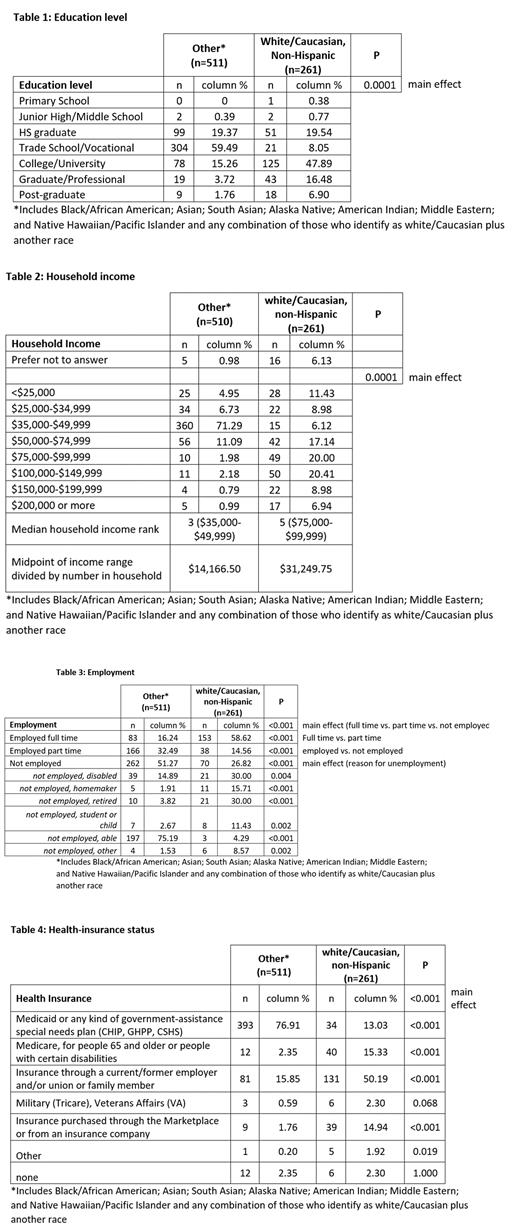Abstract
Background: Community Voices in Research (CVR) is the National Hemophilia Foundation's community-powered registry designed to provide researchers with a firsthand, 360-degree view of what it means to live with an inherited bleeding disorder (IBD) by providing insight on a wide range of areas previously not evaluated or under-evaluated in this population. Since 2019, information has been collected from those with an IBD as well as their immediate family members/caregivers. Previous QOL data-collection efforts have been narrow in scope or duration and/or relied on HCP-reported data. The self-reported, confidential, de-identified aggregate CVR data are used to improve clinical outcomes and quality of life for people with IBDs and identify research questions important to the community.
Methods: Participants complete an enrollment survey followed by the baseline then annual surveys. Additional surveys focused on specific areas of interest are issued periodically. Participants provide demographic data including race, ethnicity, level of education, household income, employment, and health-insurance status. External researchers of various collaborations may apply for access to the de-identified, aggregate data, launch individual surveys, or invite participants to virtual advisory panels. All research findings are communicated to its participants through a personalized CVR dashboard.
Results: White/Caucasians make up 86.9% of registrants; (11.3%) include Black/African American; Asian; South Asian; Alaska Native; American Indian; Middle Eastern; and Native Hawaiian/Pacific Islander and any combination of those who identify as white/Caucasian plus another race; 1.8% indicated that their race was unknown or that they preferred not to answer. Ethnicity was reported as Hispanic/Latino(a) (51%), not Hispanic/Latino(a) (46.6%), and unknown/prefer not to answer (2.4%).
Demographic data reveal significant disparities between white/Caucasian/non-Hispanic (WCNH) and other CVR participants in key social determinants of health, including education level, household income, employment, and health-insurance status. Tables 1-4 provide a detailed breakdown.
Education: The majority of WCNH participants (64.2%) reported having college/graduate/professional-level education, while among others, most (59.4%) reported having a trade/vocational school-level education.
Annual household income: The majority of WCNHs participants (57.5%) reported earnings between $50K-$149K. In contrast, the large majority (71.2%) of others reported earning $35K-$49K annually. For WCNHs participants, the midpoint of income range divided by number of people in the household was more than double that of other participants ($31,249 vs. $14,166).
Employment: Significant differences between the groups in employment were seen. WCNH participants were more likely to be employed full-time (58.6%), disabled (30%), retired (30%), homemaker (15.7%), or a student (11.4%). Other participants were more likely to be employed part-time (32.5%) or unemployed (51.3%), or able to work but were unemployed (75.2%).
Health insurance: A particularly stark disparity was noted in health-insurance type. Among WCNHs, 50.1% reported insurance through an employer or union, while only 15.8% of others fit this category. Among others, the majority (76.9%) reported enrollment in Medicaid or other public income-based insurance (vs. 13% of WCNHs).
Conclusions: The demographic disparities between WCNHs and other participants in the CVR are critical and emphasize the need to focus on correlations between known social determinants of health and self-reported health outcomes and quality-of-life information. It is well known that education level and type of insurance, for example, can have a significantly negative impact on factors such as access to treatments and healthcare and medication adherence.
CVR recruitment efforts must focus on enrolling racially and ethnically diverse participants to better understand their patient journey. This will enable the characterization of the links between racial/ethnic disparities and differences in access to care, quality of life, and related issues in the IBD community, and tailor education and advocacy efforts. As CVR data are extracted to answer a host of research questions, ensuring the inclusion of demographic disparities will benefit all members of the IBD community.
Witkop: Teralmmune, Inc.: Consultancy. Valentino: Spark: Ended employment in the past 24 months.


This feature is available to Subscribers Only
Sign In or Create an Account Close Modal